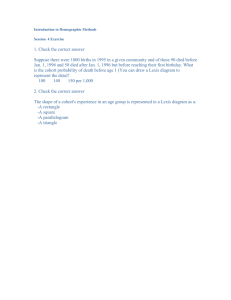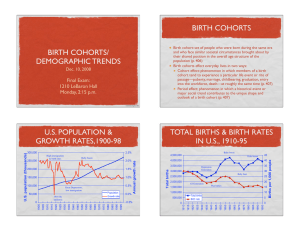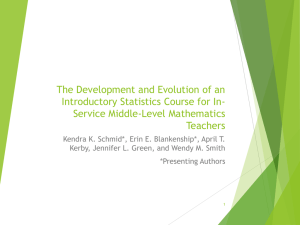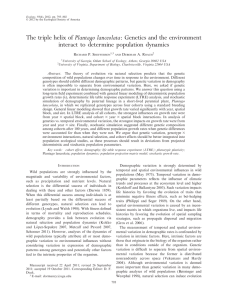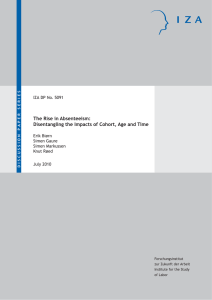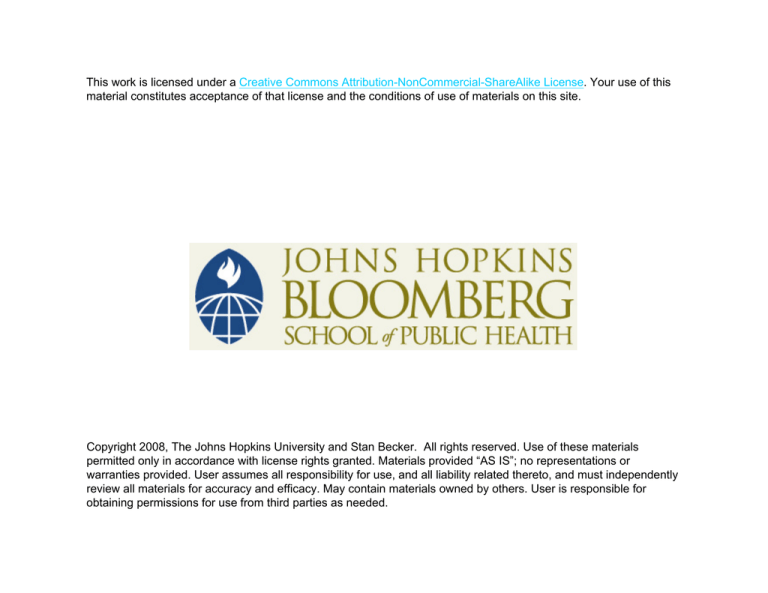
This work is licensed under a Creative Commons Attribution-NonCommercial-ShareAlike License. Your use of this
material constitutes acceptance of that license and the conditions of use of materials on this site.
Copyright 2008, The Johns Hopkins University and Stan Becker. All rights reserved. Use of these materials
permitted only in accordance with license rights granted. Materials provided “AS IS”; no representations or
warranties provided. User assumes all responsibility for use, and all liability related thereto, and must independently
review all materials for accuracy and efficacy. May contain materials owned by others. User is responsible for
obtaining permissions for use from third parties as needed.
Lexis Diagrams
Stan Becker, PhD
Bloomberg School of Public Health
Construction
Lexis diagrams provide a graphical
representation of the relationships between
demographic events in time and persons at
risk and they also assist in calculating rates
Every demographic event is characterized
by two numbers: the time (e.g., year) at
which it occurs and the age (or other
duration measure) of the person to whom
it occurs
3
Construction
4
Life Lines
A person’s life is represented in the Lexis
diagram by a straight line called “life line”
– The line begins on the time axis at the
time of the person’s birth
– Continues diagonally upwards
– And ends at the age/time point
representing the person’s death (or
other demographic event)
Continued
5
Life Lines
Continued
6
Life Lines
The sum of all the life line lengths in a
particular portion of the diagram represents
person-years lived or exposure in that area
Life lines and events can be considered
from a cohort or period perspective
7
Cohort Data
Cohort—A group of persons who
experience an event in the same time
period, e.g., birth, marriage
The Lexis diagram can show the
experience of a cohort in a particular age
interval (A)
It can also show the experience of a cohort
as they move through life (B)
8
Cohort Data
9
Period Data
Most demographic data are period data
Square (C) = person-time of exposure at a
particular age and period
A square includes the life lines from
experiences of two different cohorts
Column (D) = experience of all age groups
of interest during a specific time period
10
Period Data
11
Examples
Display of census information by age and
year of birth
12
Examples
France: Total Enumerated Population, March 10, 1946
Age in Completed
Year of Birth
Years on
Population
1-Jan-46
1946: January 1 to March 9
146,573
1945: March 10 to December 3
0
481,602
1945: January 1 to March 9
0
112,514
1944
1
565,593
1943
2
524,307
13
Examples
Source: Pressat R. Demographic Analysis: Methods, Results, and Applications. 1972
14
Examples
Each square in a Lexis Diagram represents
the experience of two cohorts (distribution
of deaths during a calendar year between
different birth cohorts)
15
Examples
France: Male Deaths in 1955,
by Year of Birth and by Age
Year of
Age in
Number of
Birth
Completed Years
Deaths
1955
0
11,400
1954
0
4,359
1954
1
986
1953
1
705
1953
2
325
1952
2
275
1952
3
218
1951
3
204
1951
4
162
Source: Pressat, 1972
16
Examples
Source: Pressat R. Demographic Analysis: Methods, Results, and Applications. 1972
17
Examples
Representation of the deaths occurring to a
specific cohort at a particular age
18
Examples
Source: Pressat R. Demographic Analysis: Methods, Results, and Applications. 1972
19
Examples
Each square in a Lexis Diagram represents
the experience of two birth cohorts
(distribution of the deaths occurring at a
specific age during a calendar year)
20
Examples
Source: Pressat R. Demographic Analysis: Methods, Results, and Applications. 1972
21
Examples
Relating events in periods of time to
cohorts of individuals—attributing period
numbers of deaths to birth cohorts
22
Examples
23
24
Summary
25

